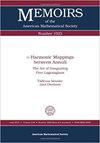Higher Ramanujan Equations and Periods of Abelian Varieties
IF 2.4
4区 数学
Q1 MATHEMATICS
引用次数: 5
Abstract
We describe higher dimensional generalizations of Ramanujan’s classical differential relations satisfied by the Eisenstein series E 2 E_2 , E 4 E_4 , E 6 E_6 . Such “higher Ramanujan equations” are given geometrically in terms of vector fields living on certain moduli stacks classifying abelian schemes equipped with suitable frames of their first de Rham cohomology. These vector fields are canonically constructed by means of the Gauss-Manin connection and the Kodaira-Spencer isomorphism. Using Mumford’s theory of degenerating families of abelian varieties, we construct remarkable solutions of these differential equations generalizing ( E 2 , E 4 , E 6 ) (E_2,E_4,E_6) , which are also shown to be defined over Z \mathbf {Z} . This geometric framework taking account of integrality issues is mainly motivated by questions in Transcendental Number Theory regarding an extension of Nesterenko’s celebrated theorem on the algebraic independence of values of Eisenstein series. In this direction, we discuss the precise relation between periods of abelian varieties and the values of the above referred solutions of the higher Ramanujan equations, thereby linking the study of such differential equations to Grothendieck’s Period Conjecture. Working in the complex analytic category, we prove “functional” transcendence results, such as the Zariski-density of every leaf of the holomorphic foliation induced by the higher Ramanujan equations.高阶Ramanujan方程与Abelian变种的周期
我们描述了由Eisenstein级数E2 E_2,E4 E_4,E6 E_6满足的Ramanujan经典微分关系的高维推广。这种“更高的Ramanujan方程”是根据存在于某些模堆栈上的向量场几何地给出的,这些模堆栈对配备有其第一个de Rham上同调的合适框架的阿贝尔方案进行分类。这些向量场是通过Gauss-Manin连接和KodairaSpencer同构规范地构造的。利用阿贝尔变种退化族的Mumford理论,我们构造了推广(E2,E4,E6)(E_2,E_4,E_6)的这些微分方程的显著解,这一考虑完整性问题的几何框架主要受到超越数论中关于Nesterenko关于Eisenstein级数值的代数独立性的著名定理的扩展的问题的启发。在这个方向上,我们讨论了阿贝尔变种的周期与更高阶Ramanujan方程的上述解的值之间的精确关系,从而将对这类微分方程的研究与Grothendieck的周期猜想联系起来。在复分析范畴中,我们证明了“函数”超越结果,例如由更高的Ramanujan方程诱导的全纯叶理的每片叶子的Zariski密度。
本文章由计算机程序翻译,如有差异,请以英文原文为准。
求助全文
约1分钟内获得全文
求助全文
来源期刊
CiteScore
3.50
自引率
5.30%
发文量
39
审稿时长
>12 weeks
期刊介绍:
Memoirs of the American Mathematical Society is devoted to the publication of research in all areas of pure and applied mathematics. The Memoirs is designed particularly to publish long papers or groups of cognate papers in book form, and is under the supervision of the Editorial Committee of the AMS journal Transactions of the AMS. To be accepted by the editorial board, manuscripts must be correct, new, and significant. Further, they must be well written and of interest to a substantial number of mathematicians.

 求助内容:
求助内容: 应助结果提醒方式:
应助结果提醒方式:


